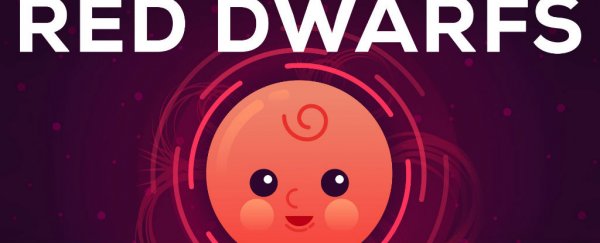
Sorry to bum you out, but the Universe is slowly dying. In the very, very distant future, our Sun and all of the other stars will burn out, leaving the Universe a very quiet place devoid of life. The last thing to burn out will be the red dwarfs - a very common, dim and small type of star that does not emit enough light for us to see without a telescope. So what makes these stars so special and what could they possibly tell us about the Universe? Luckily for us, this episode of Kurzgesagt - In a Nutshell, has the answers.
According to the video, red dwarfs make up a whopping 70 percent of all the stars in the Universe, yet you've probably never noticed them, because they're only about 7 to 50 percent as big as our Sun and emit a tiny amount of light. Though they function roughly the same way that other stars do by fusing hydrogen into helium, red dwarfs do not accumulate helium over time because the hydrogen and helium work together convectively.
The best way to envision this is to picture a normal star as a Hummer and a red dwarf as a Prius. Sure, the Hummer is more powerful, but the Prius is way more efficient over time. In fact, as the video explains, red dwarfs can burn for up to 10 trillion years, which is magnitudes longer than a normal star like our Sun, which has a lifespan of about 10 billion years.
Following that logic, red dwarfs are all still babies compared to their bigger brothers. This also means they will remain long after large stars burn out, and when they do, they'll leave behind white dwarfs - gaseous planets about the size of Earth.
Besides their awesomely long lifespans, many believe that red dwarfs may prove the best hope for humanity to find a new home after Earth because many red dwarfs have rocky planets orbiting them in the habitable 'Goldilocks Zone', where temperatures are just right to support life.
However, red dwarfs do come with their own unique set of problems for potential space colonists. For example, the planets orbiting the star would have a very tight orbit, which can cause them to get 'tidally locked'. This means that one side of the planet is always facing the star while the other side faces away. These conditions would lead to one side of the planet burning while the other freezes.
Problems aside, it's estimated that there are roughly 60 billion habitable planets orbiting red dwarfs in our galaxy alone. With that number in mind, think of how many might lie in all of the Universe - it's truly baffling to contemplate.
Check out the video above to see red dwarfs explained in much greater detail. Also, head on over to Kurzgesagt - In a Nutshell for many more videos on space and science.
